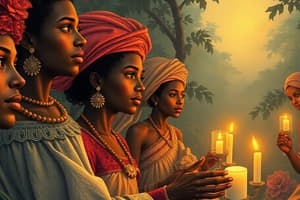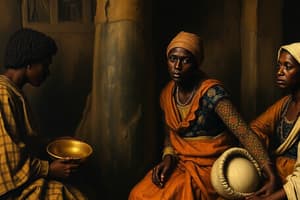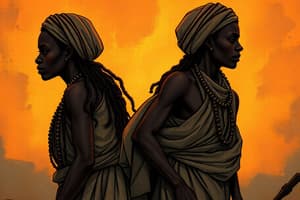Podcast
Questions and Answers
What aspect of enslaved people's existence does the book primarily focus on?
What aspect of enslaved people's existence does the book primarily focus on?
- Their social interactions and community building.
- Their commodification, experiences, and reactions to being treated as property. (correct)
- Their cultural practices, languages, and artistic expressions.
- Their political movements and resistance efforts.
The book examines the intersection between enslavers, physicians, and enslaved people. Which of the following best describes the nature of this intersection?
The book examines the intersection between enslavers, physicians, and enslaved people. Which of the following best describes the nature of this intersection?
- A detached, objective study of enslaved people's health and well-being.
- A purely economic relationship focused on maximizing profit from enslaved labor.
- A complex relationship involving aspects of ownership, medical exploitation, and control over bodies. (correct)
- A philanthropic endeavor where enslavers and physicians provided care for enslaved people.
According to the book, how were the bodies of enslaved viewed both before birth and after death?
According to the book, how were the bodies of enslaved viewed both before birth and after death?
- As individuals with inherent rights and dignity.
- As having no value until they could perform labor.
- As property with a monetary value, even in preconception and postmortem stages. (correct)
- As sacred entities to be revered and protected.
What does the book suggest about enslaved people's beliefs regarding the afterlife and burial rituals?
What does the book suggest about enslaved people's beliefs regarding the afterlife and burial rituals?
What was the 'domestic cadaver trade' and what does the book reveal about it?
What was the 'domestic cadaver trade' and what does the book reveal about it?
Jourden H. Banks's narrative provides insight into what aspect of enslaved people's lives?
Jourden H. Banks's narrative provides insight into what aspect of enslaved people's lives?
What motivated young Jourden H. Banks to retaliate against his enslaver's son, Alexander?
What motivated young Jourden H. Banks to retaliate against his enslaver's son, Alexander?
How does the book distinguish itself from other studies addressing the fiscal value of enslaved people?
How does the book distinguish itself from other studies addressing the fiscal value of enslaved people?
What key realization did Jourden H. Banks have around the age of five?
What key realization did Jourden H. Banks have around the age of five?
How does the book approach the topic of enslaved people's value?
How does the book approach the topic of enslaved people's value?
What does the reference to Benjamin Banneker's letter to Thomas Jefferson highlight?
What does the reference to Benjamin Banneker's letter to Thomas Jefferson highlight?
What does the quote from The Christian Recorder emphasize about the enslavement of African Americans?
What does the quote from The Christian Recorder emphasize about the enslavement of African Americans?
The appraisal and sale price ranges provided in the introduction indicate what about enslaved people?
The appraisal and sale price ranges provided in the introduction indicate what about enslaved people?
Flashcards
Life Cycle of Human Property
Life Cycle of Human Property
The idea that enslaved people were treated as property throughout their lives, even before birth and after death, with a monetary value attached to them.
Monetized Death
Monetized Death
The financial value assigned to enslaved people, which could be contested in court even after their death.
Domestic Cadaver Trade
Domestic Cadaver Trade
The practice of selling dead bodies of enslaved people to medical schools for dissection and anatomical study.
Intellectual History of Commodification
Intellectual History of Commodification
Signup and view all the flashcards
Commodification's Impact
Commodification's Impact
Signup and view all the flashcards
Jourden H. Banks
Jourden H. Banks
Signup and view all the flashcards
Soul value
Soul value
Signup and view all the flashcards
Monetary vs. bodily awareness
Monetary vs. bodily awareness
Signup and view all the flashcards
Spiritual and financial value
Spiritual and financial value
Signup and view all the flashcards
Appraisal Price Range
Appraisal Price Range
Signup and view all the flashcards
Sale Price Range
Sale Price Range
Signup and view all the flashcards
Human Trafficking
Human Trafficking
Signup and view all the flashcards
Benjamin Banneker's Letter
Benjamin Banneker's Letter
Signup and view all the flashcards
Study Notes
- The Value of Life and Death examines the monetary and spiritual value of enslaved people, from birth to death, and beyond
- The appraisal price range was $0-$5,771 [$169,504 in 2014]
- The sale price range was $0.14-$3,228 [$4-$94,822 in 2014]
- The book delves into the perspectives and experiences of enslaved individuals as commodities, as well as those of enslavers, traders, and medical professionals
- It sheds light on the commodification of enslaved people throughout their lives and after death
Jourden H. Banks's Experience
- Jourden H. Banks, born into slavery, experienced relative pleasantry in his early years compared to adulthood
- He lived on a Virginia plantation with his parents and sixteen siblings
- As a child, he played with the enslaver's son, Alexander, until he realized that he was being beaten
- Banks fought back, tracked the whippings, and retaliated
- Even in childhood, Banks displayed an understanding of his soul value, separate from his enslaver
- Banks realized the difference between him and his nemesis when Alex attended school while he was sent to scare crows in the fields
- He experienced a turning point/ "quantum leap" in understanding his condition
Enslaved People's Awareness
- Enslaved youth and young adults intimately learned their place in the world as they aged
- The sale of Banks's two sisters, the beating of his mother, and the death of his enslaver solidified his understanding of enslavement
- Enslaved adults knew that the death of their enslavers often meant the breaking up of their families
Banks as Property
- Banks had a message for potential buyers when put on the auction block in 1857: He fought the traders and tried to liberate himself by running away
- He remained defiant during interviews, not revealing information that would affect his monetary value
- Despite his efforts, he was purchased for $1,200
Themes
- This book examines the financial and spiritual value of enslaved people, as well as free blacks, along with the individuals who had an interest in their fiscal vitality
- Examines enslavers, physicians, and human property and shows just how commodification touched every facet of enslaved people's births, lives, and afterlives
- It addresses attitudes prior to birth and after death to challenge thought around the life cycle of human property
Organization
- Chapters represent a window into enslaved people's awareness of their monetary value and places them in conversation with enslavers' accounting of their bodies from birth to death
- The book is organized around the life cycle of an enslaved person's body
Focuses
- How it felt to have a projected or real price from preconception to postmortem and to death
- Some cadavers were trafficked and sold to medical schools for human anatomy courses
- Focus is given to domestic cadaver trade
- Exploration of enslaved people's ideas about the afterlife and their preferences for specific burial rituals, even when doctors wanted to harvest their bodies for dissection.
- Focus is given to Banks's experience as a fugitive in a Kentucky prison and his thoughts about death
Banks's Imprisonment
- Jailed in Smithland, Kentucky, in October 1857, he remained incarcerated for seven months and two days
- The jail was "more like a place of punishment than a place of detention,"
- Banks and his fellow captives vowed to not reveal real names or place of abode
- During his time in jail, physicians came to treat the sick, enslavers came in response to notices, and two whites came when convicted of murder
Encounter with Death
- Banks encountered an emaciated man who was assigned to share his cell and was near death
- The doctor who treated his sick cellmate learned that he suffered from tuberculosis and needed care
- The doctor promised to purchase and care for Banks's sick inmate
- The enslaver came to claim his property after being informed by the doctor that the inmate would not survive the journey
- The inmate's reply was that he did not care about the value of his life and would rather take him dead, as a caution to his other slaves, than not get him at all
- The enslaver refused a higher price from a doctor for a nearly dead man
- Enslaved people represent an exchangeable commodity in the eyes of traders, enslavers, and doctors
Purpose
- The recognition of self through literature, in terms of the knowledge base of enslaved people
- Literature is about what enslaved people experienced, not what they thought
- The intent is to show their intellectual side, emphasizing that Banks had particular ideas about their value that differed greatly from their enslavers
Goals
- Incorporate the voices of those traded on the auction block along with the valuations of their captivity
- Enslaved people speak back, through their words and actions and invite the reader to hear their stories, see them as human beings, and understand them as commodities
- Enslaved people of all ages recognized the multilayered values ascribed to their bodies, and, they were self-actualized
Method
- Begins before conception because even imagined lives of enslaved people had a monetary value
- Follows the maturation process to and through adulthood and and ends at death and the postmortem travels of their bodies and spirits
- Focuses on capitalism and commodification, as well as human emotions and expressions of love, loss, and grief
Enslaved Children
- Enslaved children's birth announcements came in the form of federal records or private papers.
- These private notices came from business ledgers, bills of sale, or plantation lists of births
- Rather than record details, slave owners appraised them with a monetary value that typically increased as they aged
Enslaved Death
- Death notices served as public pronouncements of a person's passing.
- These notices would signal teh opening of probate, if there are outstanding debts on the deceased's estate
- Enslaved people saw death as "carried away" or "passing on," marked a transition into another world where ther is eternal joy
- Some enslaved would see it as a vison, having 2 bodies, one eternally free and other enslaved
- Public notices about enslaved people would shed light on their personality, service, and legacy
Value of Enslaved
- Enslaved people were valued in life and in death
- Enslaved people and property had multiple sets of values encompassed by their bodies
- Value refers to a noun, verb, and adjective that requires an assessment of feelings
- The first value signifies an internal spirit or soul value, defying monetization yet speaking to the spirit and soul of who they were as human beings.
- Spirit or Soul Value: This represented the self-worth of enslaved people, whether they are those who were compliant or defiant, and others who were socially dead
Types of Valuation
- External assessments rooted in appraisals: Projected values that planters, doctors, traders, and others attributed to enslaved people based on their potential work output.
- Market value: A sale price representing human flesh that was negotiated in a competitive market/ Highest price paid for them as commodities.
- Ghost value: The price tag affixed to deceased enslaved bodies in post-mortem legal contestations or as they circulated through the domestic cadaver trade.
Post Mortem of Enslaved
- Whether buried or not, enslaved people were given a ghost value.
- Many enslaved people were sold or transported for sale to medical schools
- Ghost values were also assigned for legal and insurance purposes
- An individual enslaver could look at his or her most recent estate inventory, insurance policy, or bill of sale to find out how much one of his or her enslaved laborers was worth
- Legal disputes over hiring contracts gave courts the right to value deceased human chattel in order to settle cases
Post Mortem Trade
- Formerly enslaved and free black cadavers were used on the dissection table, in the halls of major medical schools, and by physicians
- Unclaimed bodies from blacks and whites, poor and marginalized citizens, as well as criminals of all races were subject to the cadaver trade
- Bodies were at the center of a legal process following a coroner's inquest to determine the cause of death.
- Medical research fueled the traffic in dead bodies and served as the lifeblood of the domestic cadaver trade.
Burials
- Those buried were placed in coffins (mostly pine boxes) and lowered into shallow graves
- Some people woul dreceive obituaries, headstones, and elaborate funerals
- Others entered the realm of death by way of execution, which started an extended journey of their physical bodies
- Enlsaved people lived a spiritial world, one remembering the time that "the Lord... carried me off in the spirit, and showed me this old body in the ground and my new body up in the air and me singing, 'Hark from the tune."
- However, their bodies still had economic value on earth
Previous Work
- Ruth Richardson confirmed that corpses were indeed commodities
- Ruth discovered that cadavers were "bought and sold, they were touted, priced, haggled over, negotiated for, discussed in terms of supply and demand, delivered, imported, exported, [and] transported."
- Robert Blakely, Michael Sappol, and Harriet A. Washington showed the underground disposal and traffic in dead bodies and that African Americans occupied a disproportionate majority
- Hundreds of improperly disposed African American remains were found inside the basement of the Medical College of Georgia and in a well at Virginia Commonwealth University
- Contemporary connections to these remains as well as people wo did not receive burials, are referenced
Aim
- Views of their life and death incorporate spiritual, fiscal, and physical worlds.
- Hope that the enslaved "body would not be disposed of like that of a dead animal but the book closes with some dignity and solemnity."
- Provide a pendulum swing value, devaluation, the body as property and death as liberation, so the slaves can rest in piece
Studying That Suits You
Use AI to generate personalized quizzes and flashcards to suit your learning preferences.




